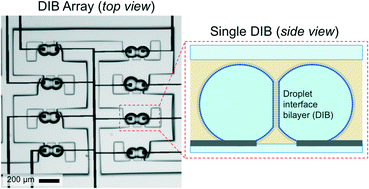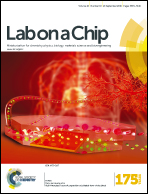Hydrodynamic trapping for rapid assembly and in situ electrical characterization of droplet interface bilayer arrays†
Abstract
The droplet interface bilayer (DIB) is a modular technique for assembling planar lipid membranes between water droplets in oil. The DIB method thus provides a unique capability for developing digital, droplet-based membrane platforms for rapid membrane characterization, drug screening and ion channel recordings. This paper demonstrates a new, low-volume microfluidic system that automates droplet generation, sorting, and sequential trapping in designated locations to enable the rapid assembly of arrays of DIBs. The channel layout of the device is guided by an equivalent circuit model, which predicts that a serial arrangement of hydrodynamic DIB traps enables sequential droplet placement and minimizes the hydrodynamic pressure developed across filled traps to prevent squeeze-through of trapped droplets. Furthermore, the incorporation of thin-film electrodes fabricated via evaporation metal deposition onto the glass substrate beneath the channels allows for the first time in situ, simultaneous electrical interrogation of multiple DIBs within a sealed device. Combining electrical measurements with imaging enables measurements of membrane capacitance and resistance and bilayer area, and our data show that DIBs formed in different trap locations within the device exhibit similar sizes and transport properties. Simultaneous, single channel recordings of ion channel gating in multiple membranes are obtained when alamethicin peptides are incorporated into the captured droplets, qualifying the thin-film electrodes as a means for measuring stimuli-responsive functions of membrane-bound biomolecules. This novel microfluidic-electrophysiology platform provides a reproducible, high throughput method for performing electrical measurements to study transmembrane proteins and biomembranes in low-volume, droplet-based membranes.


 Please wait while we load your content...
Please wait while we load your content...